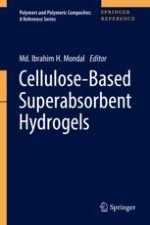2019 | OriginalPaper | Buchkapitel
4. Cellulose Solubility, Gelation, and Absorbency Compared with Designed Synthetic Polymers
verfasst von : Robert A. Shanks, Isaac R. M. Pardo
Erschienen in: Cellulose-Based Superabsorbent Hydrogels
Aktivieren Sie unsere intelligente Suche, um passende Fachinhalte oder Patente zu finden.
Wählen Sie Textabschnitte aus um mit Künstlicher Intelligenz passenden Patente zu finden. powered by
Markieren Sie Textabschnitte, um KI-gestützt weitere passende Inhalte zu finden. powered by
